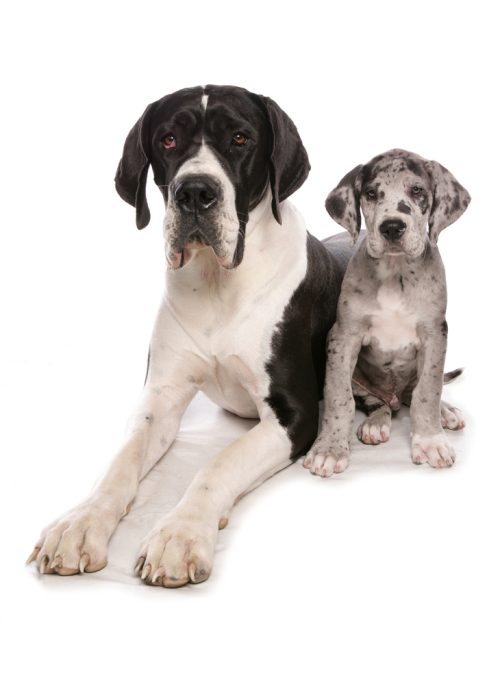
Great Danes are interesting dogs, and as it turns out, a couple of the colors they come in are especially interesting.
To review, standard colors in the breed are black, black and white, blue, brindle, fawn, harlequin, merle, silver, white, and mantle, and three markings: white markings, a black mask, and black markings.
Merle Great Danes usually have a lighter coat with darker grey spots or splotches all over, but they can also have a combination of grey, blue, white or black coats and markings. Some people confuse Harlequins with merles, but the former typically has a white base coat with irregular black patches, while the latter typically has a grey base coat.
For a period of time, people thought that the harlequin gene was a color, but if you wait long enough, science reveals nature’s secrets. In 2009, Clemson University researchers lead by Dr. Leigh Anne Clark discovered that the harlequin gene wasn’t a pigment producing gene at all, but a gene that altered the influence of the merle gene. It did it by removing the otherwise seen diluted areas of merle coloration from the coat pattern leaving behind a bi-color Dane we call the Harlequin. Bottom line? All harlequins are genetic merles, in essence a “dominant modification” of the normal (Mm) merle in that the Harlequin gene works on the merle gene to produce the Harlequin coat pattern.
Even more interesting is that while Merles and Harlequins inherit the same merle mutation, how it manifests in an individual dog will vary between dogs. The distribution of pigment can’t be controlled, so no two Danes are ever alike.
Dr. Clark has said that the separate gene for harlequin is a dominant modifier of merle that removes the dilute pigment, leaving the background white. It’s as if the harlequin gene acts like bleach by eliminating the merle’s light bleach spots on the base coat, resulting in white base-coat spots. Dogs that aren’t merle, or only have red pigment, can’t express the Harlequin gene. Since two copies of Harlequin haven’t been observed, they’re presumed to be embryonic lethal, therefore, all Harlequin patterned dogs have only one copy of the mutation.
Dr. Clark may have had an early interest in the merle coloration as she grew up with two Shelties, one of whom was a merle. She did part time work for a Sheltie breeder, helping with everything from grooming to whelping litters. You just never know what childhood experience might parlay into a career.
Image: Great Danes/Deposit Stock Photo
